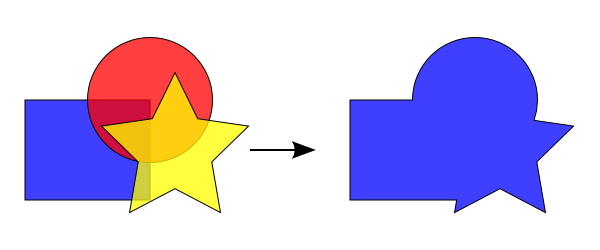| Inkscape » Paths » Path Operations |    |
|---|
Inkscape has a number of commands to form new paths from two or more preexisting paths. The z-order (see the section called “Ordering Objects (Z-order)”) of the paths is important. In all cases except for the Cut Path command, the Fill and Stroke of the new path is inherited from the bottom path. For some operations, the top path can be thought of as operating on the bottom path; that is, part of the bottom path remains and the top path is thrown away. This is explained in more detail for each operation that it applies to below. All commands are accessible under the Path menu.
Any open paths are, for the purpose of these commands, closed by a line between the path's end points. Shape objects and text objects are automatically converted to paths.
![]() Union
(Ctrl++):
Modified in v0.45.
Union of one or more paths. One new path is created, containing
all the areas of the original paths. A union of one path removes
self-intersections, creating individual sub-paths for each
section. Note that this is different from the Path
Combine command where no nodes are lost or created.
Union
(Ctrl++):
Modified in v0.45.
Union of one or more paths. One new path is created, containing
all the areas of the original paths. A union of one path removes
self-intersections, creating individual sub-paths for each
section. Note that this is different from the Path
Combine command where no nodes are lost or created.

![]() Difference
(Ctrl+-):
Difference of two paths. The area of the top path is removed from the bottom path.
Difference
(Ctrl+-):
Difference of two paths. The area of the top path is removed from the bottom path.

![]() Intersection
(Ctrl+*):
Intersection of two or more paths. The new path encloses the common area of the original
paths.
Intersection
(Ctrl+*):
Intersection of two or more paths. The new path encloses the common area of the original
paths.

![]() Exclusion
(Ctrl+^):
Exclusion of two paths. One new path is created containing the
non-overlapping areas of the original paths.
Exclusion
(Ctrl+^):
Exclusion of two paths. One new path is created containing the
non-overlapping areas of the original paths.

![]() Division
(Ctrl+/):
Division of two paths. The first path is split by the second
path. Two or more new paths are created.
Division
(Ctrl+/):
Division of two paths. The first path is split by the second
path. Two or more new paths are created.

![]() Cut Path
(Ctrl+Alt+/):
Cutting by two paths. The first path is cut by the second
path. Two or more new paths are created. The new paths do not
have any Fill.
Cut Path
(Ctrl+Alt+/):
Cutting by two paths. The first path is cut by the second
path. Two or more new paths are created. The new paths do not
have any Fill.

© 2005-2008 Tavmjong Bah. | Get the book. |